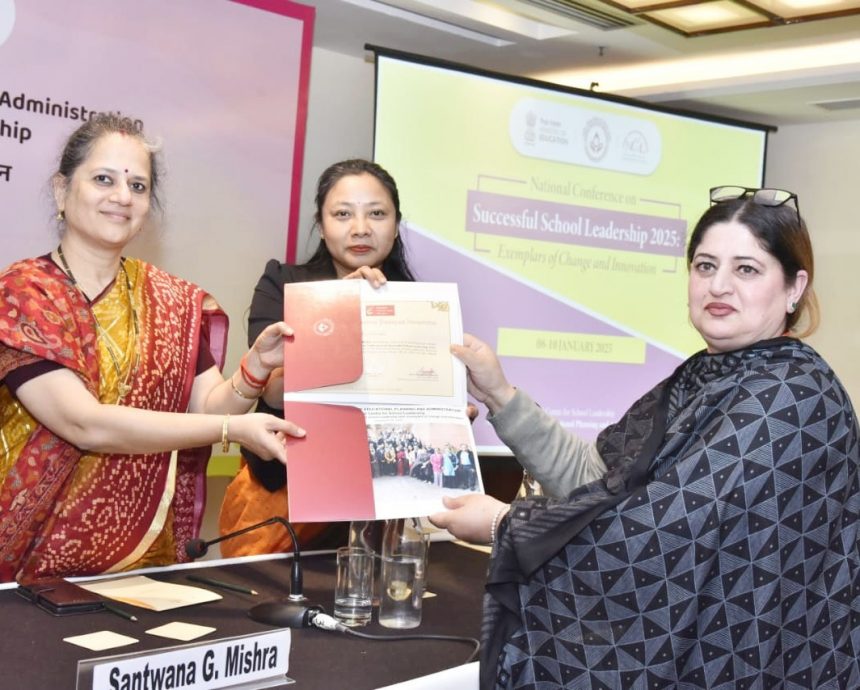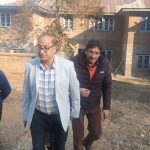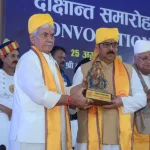In an exclusive interview with Rising Kashmir reporter Younus Rashid, Rehana Qussar, who was recently felicitated with the National School Leadership Award, speaks about working in challenging environments to create meaningful change, transforming underperforming schools into thriving learning spaces.
Rehana is currently the Head of the Institute (HoI) at Government Boys Middle School (GBMS), Yarikalan Budgam, where she has been serving for a year, she and her team have successfully increased the school’s enrollment from 32 to 70 students.
Excerpts:
Could you tell us about yourself? How did you start?
I began my teaching career in 1993 when I joined the education department. My first posting was at Nagam Middle School in Budgam district. Back then, schools were quite different—blackboards were rough and uneven, which even affected our handwriting. After about a decade, I experienced my first major transition from using chalk on blackboards to markers on whiteboards. It felt magical to hold a marker after years of struggling with chalk. Later, the introduction of smart boards further transformed classrooms, integrating technology and modern teaching methods.
These changes reflect the significant evolution in government schools, though stereotypes persist that they haven’t improved. Since day one, my goal has been to break these misconceptions and shift perceptions. I focus on growth and progress rather than dwelling on the past. Throughout my career, I’ve served in various educational roles, including at the State Council of Educational Research and Training (SCERT) and the District Institute of Education and Training (DIET), Srinagar. I’ve had around 22 postings, each exposing me to diverse environments and experiences.
Are you a teacher by chance or by choice?
I am a teacher by choice. My passion for teaching started early—I began tutoring students when I was in the 10th grade, teaching 8th graders. Even in the 11th grade, I continued tutoring because I found it intellectually stimulating and enjoyed the sense of independence it gave me. While my parents didn’t fully understand my enthusiasm back then, teaching helped me reinforce my own learning. Explaining concepts to others made my understanding stronger. This early experience showed me that teaching is not just about imparting knowledge; it’s also about continuous personal growth and learning.
What qualities should a teacher possess to become a change-maker?
To be a change-maker, a teacher needs several key qualities. First, empathy is crucial—understanding students’ emotions, backgrounds, and learning needs makes a significant difference. Passion for teaching is equally important. It’s not just a job; it’s a calling that requires genuine love for the profession.
Innovation is also vital. Traditional teaching methods are no longer enough. I’ve received recognition for introducing creative practices in my classrooms, focusing on engaging and meaningful learning experiences. A child-centric approach is essential, where the learning process revolves around the student’s interests and needs, rather than rigid curricula.
Lastly, a teacher should strive for continuous improvement, both personally and professionally. I believe in joyful learning—students should enjoy the process rather than just memorizing facts. When learning is fun, the knowledge stays with them for life.
As a head teacher, your responsibilities have increased. How do you tackle it effectively?
Managing an institution comes with significant responsibilities, and I rely on a few strategies to handle them effectively. I regularly conduct a Strengths, Weaknesses, Opportunities, and Challenges (SWOC) analysis of my school, which helps identify areas for improvement and strategic planning.
I believe in collaborative leadership, involving my staff in decision-making. At the start of every academic session, I hold meetings where teachers share ideas and suggestions, fostering a sense of ownership and teamwork.
Engaging with the local community is another key strategy. Whenever I join a new school, I connect with the community to understand their needs and involve them in school activities. This collaboration has helped increase student enrollment in the schools I’ve worked at. I prefer working in challenging environments where I can create meaningful change, transforming underperforming schools into thriving learning spaces.
How do you address the gaps often seen in government schools today?
The first step is identifying the root causes of these gaps, which often stem from outdated teaching methods, limited resources, and minimal community involvement. To address these issues, I focus on building strong relationships with my staff, ensuring they feel valued and motivated. A passionate teacher’s enthusiasm naturally reflects in their teaching.
Maintaining high morale is important. I boost teachers’ confidence through simple gestures, like encouraging professional presentation and fostering a positive outlook. Motivated teachers inspire students, creating a ripple effect throughout the school.
I’ve also shifted from traditional, rote-based assessments to competency-based evaluations, which focus on understanding rather than memorization. Additionally, I strive to be the kind of role model I admired in my childhood mentors—dedicated, passionate, and inspiring. I believe government schools have immense potential to excel with the right leadership, dedication, and a break from outdated stereotypes.
Recently, the learning levels of schools have been questioned in the ASER 2024 report. What is the way forward for improvement?
The ASER 2024 report raises valid concerns, but significant progress is underway. Improvement begins with strengthening foundational literacy and numeracy, supported by initiatives like the National Initiative for Proficiency in Reading with Understanding and Numeracy (NIPUN Bharat). This program focuses on children aged 3–9, ensuring they achieve proficiency in basic skills.
Competency-based assessments are crucial. Rather than relying on traditional exams, I use activity-based assessments where children learn through playful, engaging tasks. For example, I involve students in counting objects during fun activities, which makes learning natural and enjoyable.
Continuous teacher training and capacity-building programs are also essential. The professional development I’ve received has shaped my teaching methods and leadership style. Without regular training, it’s challenging for educators to keep up with new strategies and methodologies.
Parental involvement is another key factor. When parents are actively engaged and informed about their child’s progress, their trust in the education system grows. Strong collaboration between teachers, students, and parents is vital for improving learning outcomes.
Improvement doesn’t happen overnight—it requires consistent effort, time, and a collective approach from educators, parents, and policymakers.








